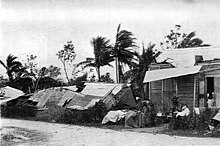San Ciriaco hurricane
| Category 4 hurricane ( SSHWS ) | ||
|---|---|---|
| Surface pressure distribution of Hurricane San Ciriaco on August 13, 1899. | ||
| Emergence | August 3, 1899 | |
| resolution | September 4, 1899 | |
|
Peak wind speed |
|
|
| Lowest air pressure | 930 mbar ( hPa ; 27.5 inHg ) | |
| dead | 3433 direct | |
| Property damage | Unknown | |
|
Affected areas |
Leeward Islands , Puerto Rico , Dominican Republic , Haiti , Bahamas , North Carolina , Azores | |
| Season overview: Atlantic hurricane season 1899 |
||
The San Ciriaco Hurricane or Puerto Rico Hurricane of 1899 was an intense and long-lasting tropical cyclone of the 1899 Atlantic hurricane season . The Cape Verde-type storm crossed Puerto Rico on August 8th and 9th, 1899 , where due to its passage a high number of fatalities from flooding was to be mourned. The fourth hurricane of the season reached at least the strength of a tropical storm for 28 days, making it the longest-lasting tropical cyclone in the Atlantic Ocean since systematic weather records began, before Hurricane Ginger . The accumulated cyclone energy of San Ciriaco was from the National Hurricane Center estimated at 73.57. This is the highest value for a tropical cyclone in the Atlantic basin.
Storm course
The tropical cyclone that later devastated Puerto Rico developed in the tropical Atlantic on August 3, presumably from a tropical wave. It moved in a west-northwest direction and intensified into a hurricane on August 5th. As the storm approached the Leeward Islands on August 5, the hurricane intensified into a severe hurricane that hit the islands of Dominica , St. Kitts and Guadeloupe with strong winds on August 7. It continued to strengthen to reach its greatest intensity with sustained winds of 150 mph before it hit southeastern Puerto Rico on August 8th . August 8th is the name day of Saint Cyriacus . The hurricane crossed the island facing west-northwest and the maximum winds consistently reached between 175 and 225 km / h.
After the storm passed Puerto Rico, it grazed the north of the Dominican Republic as a Category 3 hurricane, but did not cause any significant damage because it passed far enough north of the island. It then moved across the Bahamas , maintaining its strength on its slow move north. After drifting northeast, the storm turned northwest and hit the Outer Banks on August 17th . The hurricane moved northeast over North Carolina and came back over the waters of the Atlantic Ocean on August 19. It continued on its way east and became extra-tropical on August 22nd.
The now extra-tropical storm turns to the southeast and became a tropical storm again on August 26th. Most of the time until the end of its existence, San Ciriaco drifted there, first to the northwest, then to the east. The storm intensified again into a hurricane when it passed over the Azores on September 3 . This intensification did not last long and the storm became extra-tropical again on September 4th. The storm then swept away towards the northeast Atlantic and dispersed.
Effects

Estimates of the death toll from the hurricane range from 3,100 to 3,400; the crop damage in Puerto Rico runs into the millions of dollars . Due to the persistence of the winds and rain as it migrated across North Carolina, this state suffered significant losses in tobacco and corn crops .
The island of Puerto Rico was hit hardest by the hurricane. It was literally transformed into a swampy landscape by a 28-day long rain, whereby the general bad situation in Puerto Rico worsened (see History of Puerto Rico ).
Weather records
The San Cirriaco hurricane set a number of weather records during its existence. With nearly 3,500 people killed in Puerto Rico , it was the most momentous hurricane on the island and was also the strongest hurricane to cross the island for three decades - up to Hurricane San Felipe Segundo , a Category 5 hurricane from 1928. Still ranked today San Ciriaco ranks 10th on the list of Atlantic hurricanes with the most fatalities.
Its Accumulated Cyclone Energy (ACE) was 73.57 - the highest known value of all tropical cyclones in the Atlantic Basin. Only one other hurricane, Ivan in 2004, scored an ACE above 70 but failed to surpass the ACE of the San Ciriaco hurricane.
San Ciriaco is also the longest lasting Atlantic tropical cyclone with 28 days, with its subtropical phase the storm even existed for 31 days. Globally, the storm ranks second behind Hurricane John in the 1994 Pacific hurricane season .
See also
Individual evidence
- ↑ An eyewitness account of the passage of the hurricane through the town of Ponce is from Bailey Ashford [1934]: A Soldier in Science . Morrow, New York 1998, ISBN 0847703517 . who was stationed on the island at the time.
literature
- Stuart B. Schwartz: The Hurricane of San Ciriaco: Disaster, Politics, and Society in Puerto Rico, 1899–1901 . In: Hispanic American Historical Review . 72, 1982, pp. 303-334. doi : 10.2307 / 2515987 .
Web links
- NOAA : Highlights of Re-analysis (English)
- Unisys : Railway Archive (English)
- Library of Congress : Hurricane San Ciriaco (English)
- Puerto Rico Hurricanes and Tropical Storms (English)

